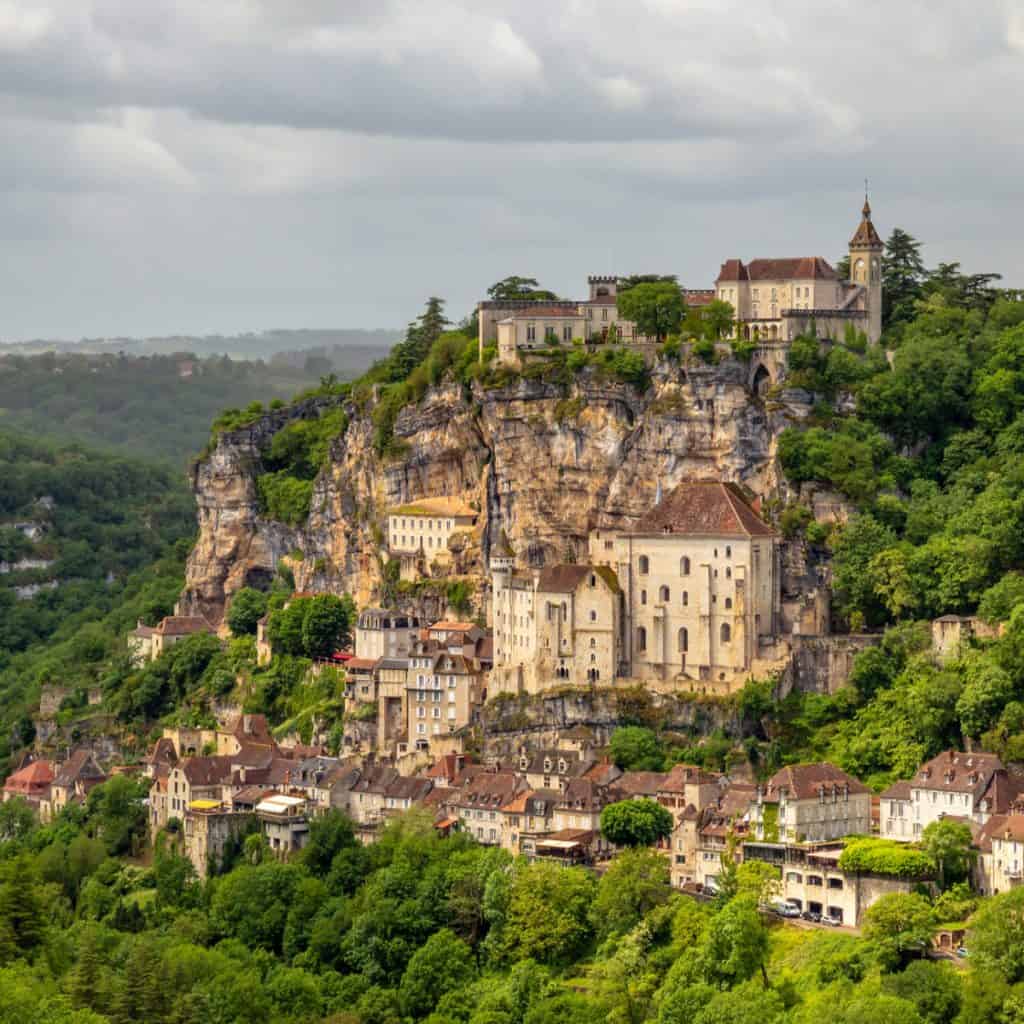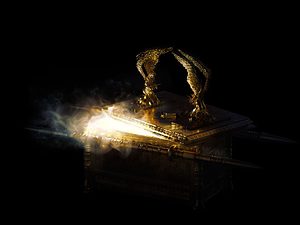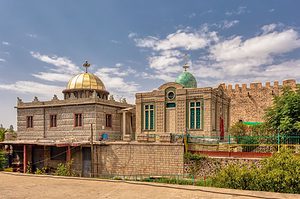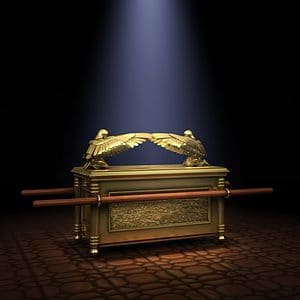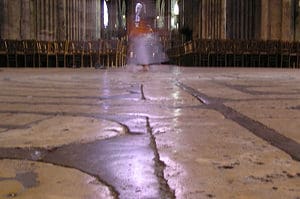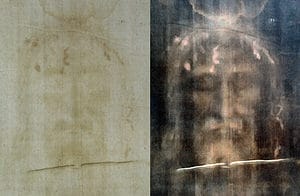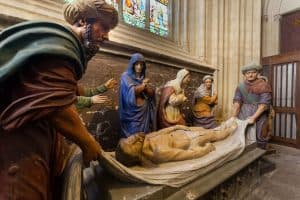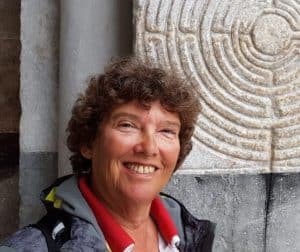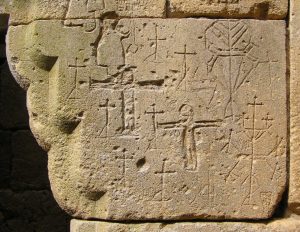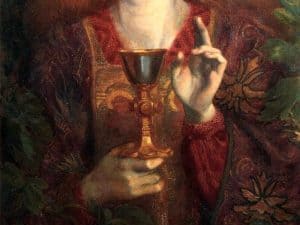Rocamadour is a place of pilgrimage. It is known for its Black Madonna, the tomb of Amadour and a bell that rings when a ship is in distress. Rocamadour has been attracting pilgrims for more than a thousand years and this is why.
Organized Tours
The history of Rocamadour
In the 3rd century, Saint Saturnin (Sernin) from Toulouse visited Rocamadour. In 778, Roland, the famous hero of the Song of Roland, passed Rocamadour on his way to Roncesvalles. His renowned sword Durendal protrudes into a rock face above the church. But it was Abbot Géraud d’Escorailes who made Rocamadour famous.
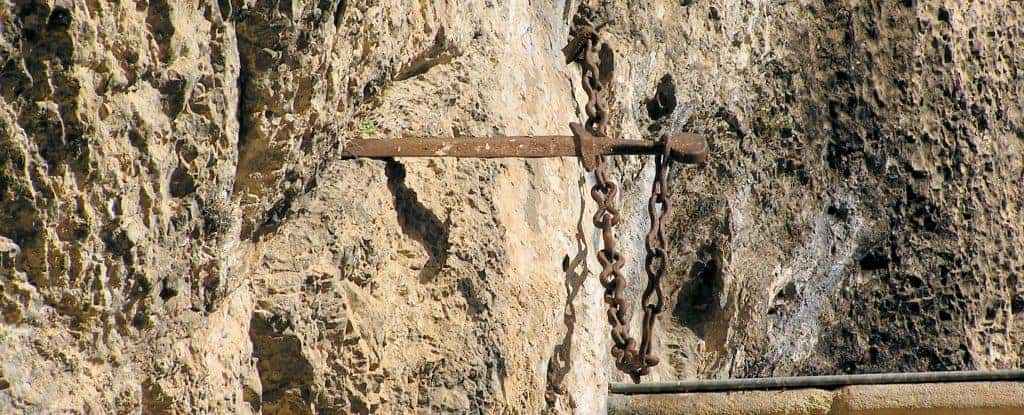
Géraud d'Escorailles
In 1105 the Notre Dame de Rocamadour was first mentioned in a papal decree. The Benedictine abbey of Tulle was commissioned to investigate the wonders of Rocamadour. When Géraud d’Escorailles became abbot in 1153, things suddenly went fast. In a short time, he managed to transform the relatively unknown place of pilgrimage into one of the most important destinations for pilgrims of that time.
The first recorded miracles took place in this period (1148). In 1159 Henri Plantagenêt, also known as Henry II, King of England visited Rocamadour. A visit from such an eminent gentleman already indicates the importance of this place as a place of pilgrimage. Still, the real attraction of Rocamadour is due to the miracle of 1166.
The Miracle of 1166
In 1166 a mysterious body was discovered. One of the parishioners had indicated that he wanted to be buried near the church entrance. When they dug the grave, they found a body that was still completely intact. This miraculous body was placed close to the altar and thus shown to the pilgrims who visited the church.
Troubadours in the 13th century sung about Amadour’s body:
Ce fut, si com dit l’autour,
le beneoit Saint Amadour.
Son cors, ce cet-on tout de fi,
est entiers, c’onques ne porsi,
encore le voient mante gent
a Rochemador, voirement,
là où il gist, bien le set-on
It was, as our author says
the blessed Saint Amadour
His body – we know for sure
is whole and never rots
Many people indeed
see him thus at Rocamadour
where he was burried, as is wel known
In 1562, almost four hundred years after its discovery, the body was destroyed. An eyewitness mentions that the Huguenots looted the church and set the body on fire. Because the body did not burn, the Huguenots tore the body into small pieces. The tomb at the entrance of the church is a reminder of Amadour.
Who was the Amadour of Roc-Amadour?
Probably no one existed with the name Amadour. Rocamadour was previously known as Rocamajori – the big rock. Archeologists found a cave with paintings nearby. This indicates that the site was already in use at the time of the cavemen. The name Rocamajori has changed over time to Rocamadour. The name change gave rise to the story that an unknown hermit named Amadour lived here.
Amadour or Amator means lover or friend. The name thus points at the lover or friend of God.
However, in the 15th century a new myth was created.
The body they had found was not very large, so the priests soon thought of the story of the tax collector Zacchaeus. The Bible says that Zacchaeus was a Jewish interpreter, small in stature. That’s why he climbed a fig tree to see Jesus. When Jesus walked past him, He looked up and asked him to come down. Jesus stayed that night in the tax collector’s house. Zacchaeus converted after this visit and donated half of all his possessions to the poor.
Later this story was added: Zacchaeus marries Veronica, the woman who wiped the sweat from Jesus’ forehead during the Stations of the Cross. After Jesus’ death, the couple fled to France. Veronica dies, and Zacchaeus retires to Rocamajori as a hermit.


The miracle book of Rocamadour
Commissioned by Géraud d’Escorailles, a miracle book is written. In it, 126 miracles, which took place in Rocamadour, have been recorded.
This book was translated into English. The Miracles of Our Lady of Rocamadour, tells the story of the miraculous healing of the deaf, crippled, and possessed, but also of miraculous victories. In short, this book is worthwhile for people interested in these types of stories.
Notable visitors
In addition to Bernhard de Clairvaux (Cistercians) and Saint Dominic (Dominicans), many famous people have climbed the stairs to Rocamadour. Henry II made the journey barefoot. Louis the Saint, Simon de Montfort, Charles the Fair, Blanche of Castille, and Philip the Bold also climbed the 216 steps.
Rocamadour, a pilgrimage as penance
The Biekorf is a Flemish (Belgium) historical magazine. In Volume 67 from 1966, there is an article on “Onse Vrauwe in Rutsemadoene” (Our lady of Rutsemadoene).
Rutsemadoene (the rock of Madonna) was the Flemish corruption of Rocamadour. The article shows that the pilgrimage is mentioned around 1300 as the destination of a penal pilgrimage.
Civilians were given a pilgrimage as penance for crimes they had committed. Depending on the municipality where they lived, the ‘sinner’ could buy off this penance. In Ghent and Dendermonde, the prize was 5 pounds. In Aalst, you had to pay an unprecedented 12 pounds, which was as much as for the trip to Santiago de Compostela.
Of the rich citizens, only a minority of the convicts actually made the penitential tour.
However, the pilgrimage to Rocamadour was also undertaken voluntarily by many. A pilgrimage was considered a sacred act carried by the community. This meant that the community (or church) took care of family and property in the absence of the pilgrim. The pilgrim was inviolable and could stay in passer-by or pilgrim houses. The reward of a journey was the indulgence, an ecclesiastical proof that could be shown at the gate of heaven as evidence of a pious act.
12 remarkable things to explore in Rocamadour
What the pilgrim encountered in Rocamadour can also be visited as a tourist. Below is a list of the most important sights.
1. The pilgrimage staircase
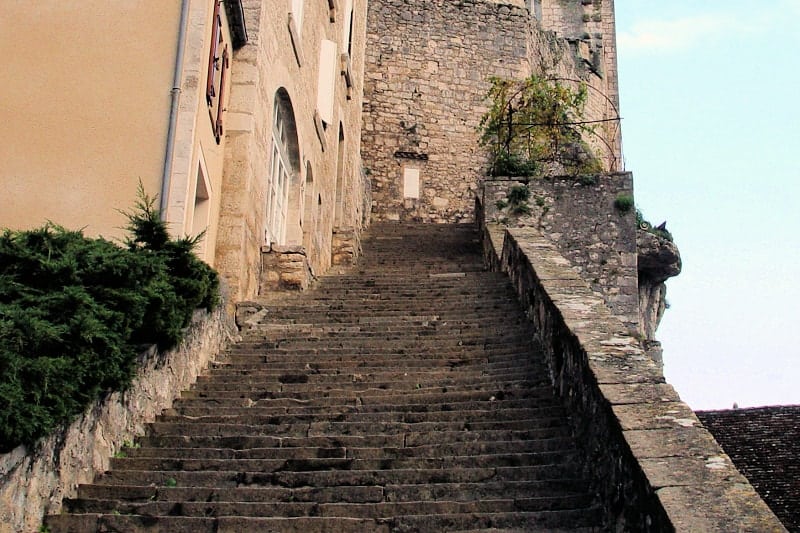
The pilgrims often climbed the 216 steps from the stairs to the sacred part in Rocamadour on their knees. Sometimes the pilgrims cuffed themselves to make it even more challenging to complete the journey. People sometimes cried out in pain, an expression that was not much appreciated when others were in the church with a service. Security guards then stormed to the stairs to call the pilgrims to silence, with caning!
2. The Notre Dame Chapel
Once at the top, in the center of all the sanctuaries, one arrives at the chapel of Notre Dame. After a fall from a rock in 1479, it was rebuilt and enlarged. It was then rebuilt again after the plundering by the Huguenots in 1562. Finally, in the 19th century, the chapel was restored and enlarged to its current condition.

On the wall at the entrance, you will now find a fresco with three skeletons. In the Middle Ages, these images were typical; they reminded the living of their mortality. Sometimes, as in this image, the dead were aggressive. In the past, three knights on horseback were depicted stopping in dismay at the sight of the dead.
Unfortunately, the fresco was partly lost due to a new window.
3. The Sword Durendal
Also, look up to admire the sword Durendal.
A nephew of Charlemagne is said to have given the sword to Rocamadour. However, there is also a story circulating that the dying Roland threw the sword away in Roncivalles and that it miraculously ended up in the rock at Rocamadour.
4. The tomb of Amadour
 Before you enter the church, you can also see the tomb of Amadour. The undamaged body was found at this location. The remains are since 2016 displayed in the basilica in a reliquary made by the artist David Pons.
Before you enter the church, you can also see the tomb of Amadour. The undamaged body was found at this location. The remains are since 2016 displayed in the basilica in a reliquary made by the artist David Pons.
5. The black Madonna of Rocamadour
Inside the Notre Dame Chapel you will also find the black virgin of Rocamadour. She is difficult to see because she is hidden away in her niche above the altar. But, for her safety, that’s a good place. She has already endured a lot:
- She was trampled and stoned by the Huguenots in 1562 and narrowly escaped the fire.
- In 1885 she was robbed of a crown, which she had been wearing since the 15th century and had been given to her by Pope Pius II.
- In 1942 she was bricked in to prevent her from being taken away by the Germans. Because of this last adventure, she is affected by moisture.
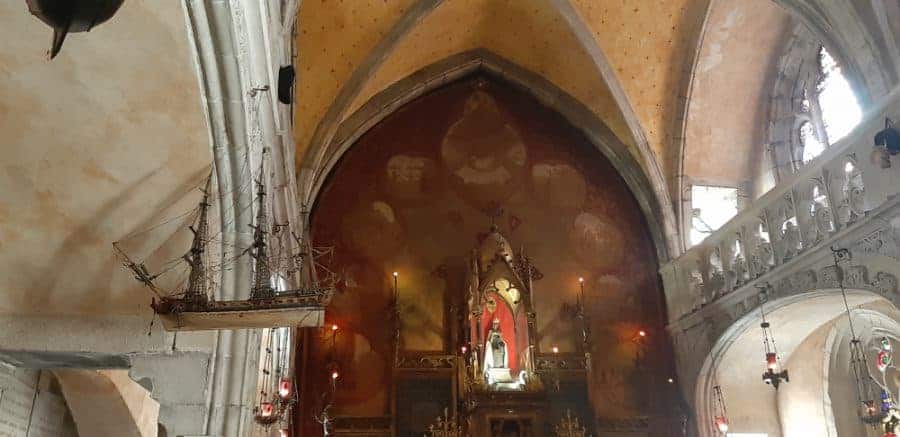
It is notable that people only speak of the black Madonna from the 17th century onwards. Until then, it was just the Notre Dame of Rocamadour. As a result, it is thought that the soot of candles colored her. Numerous Madonna statues were painted in vivid colors and covered with jewels. Perhaps she lost her color and treasures in the looting in 1562. However, history does not mention this.
6. The miraculous bell
The ships in the chapel will catch your eye rather than the miraculous bell.
This bell was forged more than a thousand years ago. It hangs on a kind of handle and has the curious habit of ringing when a ship is in distress. Canons and residents write down the date and time so that one can look this up when a castaway comes by to thank Mary.
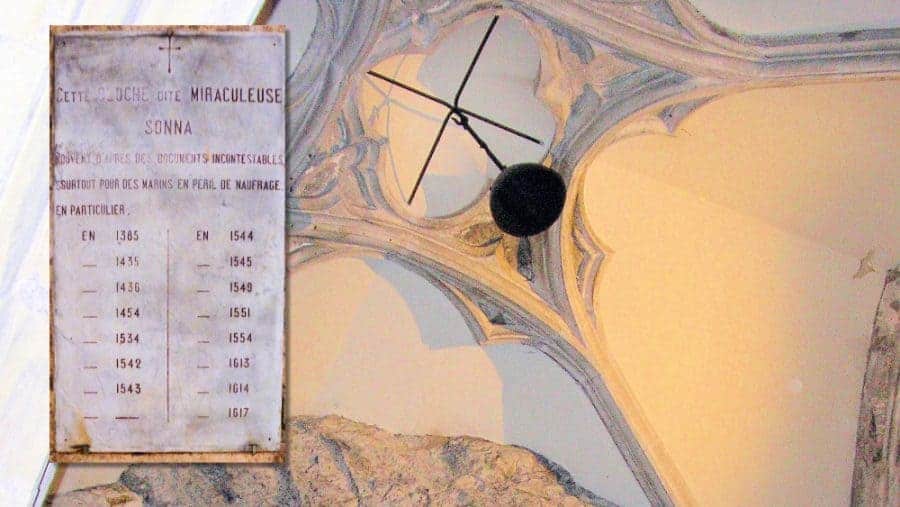
You now see models of ships that were once rescued and now testify to this miraculous rescue as an ex-voto.
On the wall hangs a stone placard on which you can read exactly when the bell rang. In the seventeenth century, people stopped writing the years. After that time, however, the bell still sounded often.
“The last time the bell rang on September 29, 2008,” said a local guide when I visited Rocamadour a few years ago. “A few months later, two young men came to tell them that they had fallen into a storm near Morocco. In their agony, they had prayed to the Virgin of Rocamadour and were saved.”
7. The Chapel of Saint Michael (12th century)
A unique fresco is visible on the outside of the chapel. It is located at the height of eight meters and has never been restored. The two scenes represent the announcement and the visitation. At the announcement, you see the angel reciting the Hail Mary. The dove on Mary’s head represents the Holy Spirit. The visitation is Mary’s visit to her cousin Elisabeth, who was pregnant with John the Baptist. The painting flows into the rocks.
This fresco was part of a larger scene that no longer exists.

Inside, you can also see a fresco. It is a 13th-century fresco of Christ surrounded by evangelists. On the left, you see Saint Michael with a scale. He negotiates whether or not the dead can go to heaven. You can see a seraph, a celestial being (angel) with three pairs of wings, on the right.
8. The abbey of Rocamadour
The former abbey has completely changed since its restoration in the 19th century. Part of the abbey is now a museum.

9. St. Savior Basilica
As mentioned before, since 2016 the relics of Amatour are displayed in the basilica.
This basilica is the largest sanctuary in Rocamadour. This church, which received the status of basilica in 1913, served as a shelter for pilgrims until 1900. The two particularities you can see here are the statue of Christ with the lance cut on the right (usually this is on the left) and the tomb of Arnaud de Saint Astier, the first bishop of Tulle and Rocamadour.
10. The Saint Amadour church
The Saint Amadour church is the most original church, which, thanks to its lower location, is also called the crypt.
In pure Romanesque style, the crypt was built in the 12th century with the aim of enlarging the terrace. It serves as the foundation for the upper church. For 400 years, until the religious wars, the relics of Saint Amadour were exhibited here without deteriorating.
11. The way of the cross

A meandering walk follows the Stations of the Cross between the iron cross at the top of the cliff near the castle and the Sanctuary below. Starting at the Religious Sanctuary, the trail climbs sharply uphill.
Each Station of the Cross shows a scene from Christ’s journey through Jerusalem’s Via Dolorosa to Mount Calvary and his crucifixion. Each station features a modest shrine with a painting of a scene from Jesus’ journey to Mount Calvary, as well as a brief description of the scenario.
Near the finish, one of the Stations has been carved out of the rock and is supported by large stone pillars. A statue of Jesus is being placed in his tomb within.
The big cross at the cliff’s summit is the final station, and there are some spectacular views of Rocamadour and the valley.
In fact, the way of the cross was one of the reasons I visited Rocamacour for the first time in 2002.
We were on our way to Rennes le Château with a group of researchers. A story circulated on the internet that the Stations of the Cross of Rocamadour and Rennes le Château were the same. This turned out not to be true. In retrospect, I was grateful for this stopover. Rocamadour is one of the unique and exciting places to visit when you are in department of Lot in France.
12. The castle of Rocmadour
The castle of Rocamadour was built in the Middle Ages to guard the community’s Sanctuary and sits majestically at the top of the settlement.
Only the ramparts of the castle are open to the public, but the views of the Alzou Valley are stunning. Keep your eyes out for birds flying to and from the neighboring ‘Rocher des Aigles’ falconry performance.
In the vicinity: Prehistoric Grotte des Merveilles
The prehistoric Grotte des Merveilles, located nearby, features an underground world of stalactites, lakes, and authentic Paleolithic engravings of horses and animals dating back to 20,000 B.C. The artworks were created by airbrushing red and black pigment onto the rocks using animal bones as stencils and a variety of other stencils such as hands. With only a short stroll down few steps, the cave is easily accessible.
Practical information
Parking
There are several parking options around Rocamadour.
You have to pay for parking at the bottom of the city, and you can be driven to the town by a tourist train. The train only goes to the shopping street. From there, you still have to walk up. I would skip the train and walk, just like the pilgrims of the past.
Upstairs at the castle, you can park for free. Then, you walk down via the Stations of the Cross. You will then visit Rocamadour in reverse order.
Elevators
You can use a paid elevator, which is probably a good idea for people who walk badly or have small children with them. The elevator allows you to skip the pilgrim’s staircase and the way of the cross.
Places to Stay
In the lower town you can do some shopping, visit restaurants and there are a couple of nice hotels. You can use the map below to see what hotels are available. Just fill in the dates.
I recommend using Booking.com, because it is easy to use, and it is the most complete hotel booking system in Europe.

